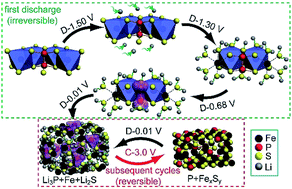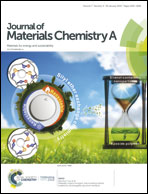2D few-layer iron phosphosulfide: a self-buffer heterophase structure induced by irreversible breakage of P–S bonds for high-performance lithium/sodium storage†
Abstract
To pursue an anode candidate with a high capacity and favorable potential is urgent for a prospective energy storage system. In this work, an earth-abundant ternary metal phosphosulfide, here FePS3, which is expected to combine the merits of metal sulfide and phosphorus, is explored for lithium/sodium storage. In order to facilitate charge transfer and relieve volume stress on the electrode, oriented nanoengineering with few-layer FePS3 nanosheets uniformly anchored into a porous graphene network was carried out. Consequently, excellent lithium storage capacities of 842.7 and 570 mA h g−1 were delivered after 120 cycles at 0.1 A g−1 and 1000 cycles at 1 A g−1, respectively. Moreover, the electrode showed excellent cycle stability for sodium storage, delivering a reversible capacity of 256.4 mA h g−1 after 300 cycles at 0.05 A g−1. The electrochemical performance is competitive compared with the state-of-the-art binary metal sulfides and phosphides. Besides oriented nanoengineering, more interestingly, an intrinsic phase evolution mechanism plays a substantial role in the favorable electrochemical reaction. Through characterization by ex situ XRD, FT-IR, HRTEM, and EIS studies, for lithium storage, single-phase FePS3 is irreversibly transformed into nano-sized FexSy and a phosphorus heterophase structure accompanying the breakage of P–S bonds after the first cycle. In view of the different lithiation potential, in situ formed mixed phases can serve as an inert buffer matrix for each other, alleviating the aggregation and pulverization of electrodes caused by volume change. This study proposes a synergistic pathway, which combines the advantages of oriented nanoengineering and an intrinsic phase evolution process to achieve high-performance lithium/sodium storage for metal phosphosulfide.

- This article is part of the themed collection: 2019 Journal of Materials Chemistry A HOT Papers


 Please wait while we load your content...
Please wait while we load your content...